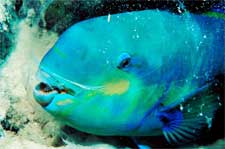|

 Fish or Fowl? Parrotfishes are named for their oral dentition: their numerous teeth are arranged in a tightly packed mosaic on the external surface of the jaw bones, forming a parrot-like beak which is used to rasp algae from coral and other rocky substrates. Many species are also brightly colored in shades of blue, green, red and yellow, but are not especially popular in aquaria. Fish or Fowl? Parrotfishes are named for their oral dentition: their numerous teeth are arranged in a tightly packed mosaic on the external surface of the jaw bones, forming a parrot-like beak which is used to rasp algae from coral and other rocky substrates. Many species are also brightly colored in shades of blue, green, red and yellow, but are not especially popular in aquaria.
Maximum sizes vary widely within the family, from 20 cm in the smallest species, such as the green parrotfish (Leptoscarus viagiensis) to 1.5 m in the largest species, Bolbometopon muricatum.
Change is Good: The development of parrotfishes is complex and accompanied by a series of changes in coloration termed polychromatism. For most species, adult males and females have different colors, the females usually displaying drab tones of green, brown or gray, and the males vivid, conspicuous colours.
Dressed in their Best: In the mediterranean parrotfish, it is the females that have vivid coloration with the males being drab gray. In most species, the juveniles have a different color pattern than the adults and some tropical species this juvenile coloration can be altered temporarily to mimic the appearance of other species.
Arrested Adolescence: As the juveniles mature they enter what is termed the initial phase coloration during which they may change color and sex. For most species, initial phase fishes are usually males that have the beginnings of the adult male coloration. However, initial phase fishes may include sexually mature females. The high variability in coloration of parrotfish has led to the different phases of many species being erroneously classified as different species in the past. Coloration is highly variable even among members of the same species. This "identity crisis" is shared by their close relatives, the wrasses of the family Labridae.

Dinner Time: Although they are considered to be herbivores, parrotfish eat a wide variety of organisms that live on coral reefs. Some species, for example Bolbometopon muricatum may include living corals (polyps) in their diet. Their feeding activity is important for the production and distribution of coral sands in the reef biome and can prevent algae from choking coral. Ingested during feeding, coral rock is ground up by the pharyngeal teeth.
 Camping Out: Parrotfishes are diurnal and stay within shallow waters of no more than about 70 meters in depth. By night they cram themselves into crevices, some species secreting a thick coat of mucus as a sort of sleeping bag. The mucus is thought to mask their scent from nocturnal predators and may serve to protect the fish from infection by parasites. Camping Out: Parrotfishes are diurnal and stay within shallow waters of no more than about 70 meters in depth. By night they cram themselves into crevices, some species secreting a thick coat of mucus as a sort of sleeping bag. The mucus is thought to mask their scent from nocturnal predators and may serve to protect the fish from infection by parasites.
It should also be noted that, after a massive die-out of the sea urchins in the Caribbeans, parrotfish now are the main grazers in the area.

School's Out: Known as the "ruminants of the sea," grazing parrotfish of most tropical species form large schools grouped by size. Harems of several females presided over by a single male are the norm in other species, the males vigorously defending their status if challenged. Curiously, if the dominant male of a harem is removed, one of the females will change sex and adopt the terminal male coloration. Parrotfish are pelagic spawners; that is, they release many tiny buoyant eggs into the water which become part of the plankton. The eggs float freely, settling into the substrate until hatching.
All text is available under the terms
of the GNU Free Documentation License
|